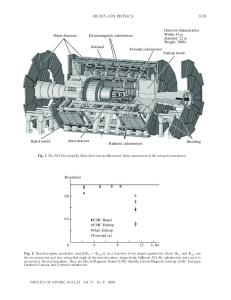Feasibility study of heavy ion physics program at NICA
- PDF / 3,453,238 Bytes
- 27 Pages / 612 x 792 pts (letter) Page_size
- 26 Downloads / 355 Views
easibility Study of Heavy Ion Physics Program at NICA1 P. N. Batyuka, *, V. D. Kekelidzea, V. I. Kolesnikova, O. V. Rogachevskya, A. S. Sorina, b, and V. V. Voronyuka aJoint
Institute for Nuclear Research, Dubna, 141980 Russia National Research Nuclear University “MEPhl” (Moscow Engineering Physics Institute), Moscow, 115409 Russia *e-mail: [email protected]
b
Abstract—There are strong experimental and theoretical evidences that in collisions of heavy ions at relativistic energies nuclear matter undergoes a phase transition to the deconfined state—Quark Gluon Plasma. The caused energy region of such transition was not found at high energy at SPS and RHIC and search for this energy is shifted to lower energies, which will be covered by the future NICA (Dubna), FAIR (Darmstadt) facilities and BES II at RHIC. Fixed target and collider experiments at the NICA facility will work at the energy range from a few AGeV up to s NN = 11 GeV and will study the most interesting area on the nuclear matter phase diagram. The most remarkable results were observed in the study of collective phenomena occurring in the early stage of nuclear collisions. Investigation of the collective flow will provide information on Equation of State (EoS) for nuclear matter. Study of the Event-by-Event fluctuations and correlations can give us signals of critical behavior of the system. Femtoscopy analysis provides the space-time history of the collisions. Also, it was found that baryon stopping power revealing itself as a “wiggle” in excitation function of curvature of the (net)proton rapidity spectrum relates to the order of the phase transition. The available observations of an enhancement of dilepton rates at low invariant masses may serve as a signal of the chiral symmetry restoration in hot and dense matter. Due to this fact, measurements of the dilepton spectra are considered to be an important part of the NICA physics program. The study of strange particles and hypernuclei production gives additional information on the EoS and “strange” axis of the QCD phase diagram. In this paper a feasibility of the considered investigations is shown by the detailed Monte Carlo simulations applied to the planned experiments (BM@N, MPD) at NICA. DOI: 10.1134/S1063779616040031
CONTENTS 1. Introduction 2. Physics studies for the MPD 2.1. Collective phenomena 2.1.1. Anisotropic flow 2.1.2. Charged azimuthal correlations 2.1.3. Baryon stopping power 2.1.4. Femtoscopic studies at the NICA energies 2.2. Measurements of dilepton spectra at NICA/MPD 2.3. Study of hyperon production at NICA/MPD 2.4. NICA/MPD prospects in hypernuclei production 3. Physics studies at the Nuclotoron energies 4. The NICA White Paper proposals 5. Summary 1 The article is published in the original.
On behalf of the BM@N and MPD Collaborations.
540 544 544 545 548 551 553 557 559 560 561 562 563
1. INTRODUCTION The main goal of physics program at the Nuclotron-based Ion Collider fAcility (NICA) accelerator complex is a search for the mixed phase of quark matter and baryon rich hadr
Data Loading...











